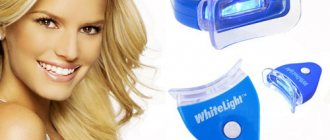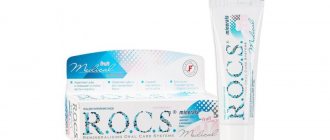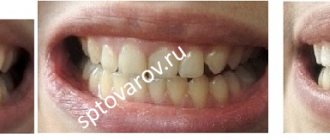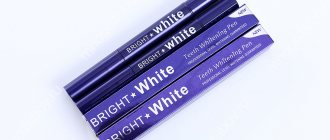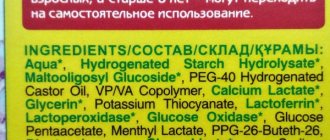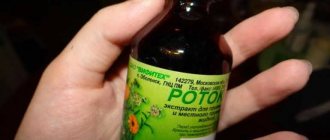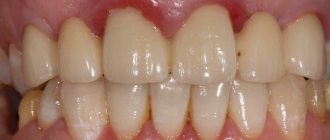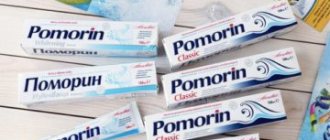Why do you need to brush your teeth?
Oral hygiene is not only a matter of aesthetics. It is due to medical reasons. A plaque constantly forms on the enamel, consisting of: • food particles; • saliva; • waste products of microorganisms inhabiting the oral cavity.
The process of plaque deposition does not depend on whether a person ate in the interval between brushings. If it is not removed, over time it turns to stone. Contamination not only creates a cosmetic defect. Deposits contribute to the violation of the integrity of the enamel. Pathogenic bacteria penetrate into the resulting cracks and actively multiply under conditions of poor hygiene. This is how caries begins with all the known consequences. These microorganisms also attack the gums. In people who neglect to brush their teeth, gingivitis becomes chronic. If the inflammation is not treated, complications in the form of periodontitis and periodontal disease are possible. As a result, the root no longer holds in the socket and the tooth falls out.
Rating of hygiene products for children
Young parents pay increased attention to the choice of this type of product. It should be safe for the child, clean enamel and care for the oral cavity. At the same time, it does not cause negative effects even if swallowed.
It is important to consider the child's age. The active formula of products for the first erupted teeth, for milk and permanent teeth is different.
A special requirement is a pleasant taste and smell. If the baby doesn’t like it, it will be very difficult to teach the child personal hygiene.
- PRESIDENT Baby
- SPLAT Baby
- ROCS Kids
- LACALUT Kids 4+
- Colgate Elmex "Junior"
How to brush your teeth correctly?
It is a mistaken idea that everyone can do this. There are a number of rules, many of which are either unknown or ignored. However, only compliance with them guarantees effective cleaning of the enamel: • Carrying out hygiene procedures not only at home, but also at the dentist. • Rational selection of brushes and paste. • Using the optimal teeth brushing method. • Using dental floss, brushes and mouthwash. • Taking into account the condition of the gums, the presence of braces and dentures. • Compliance with the rules for storing, cleaning and replacing brushes.
Tablets for determining plaque will help you understand whether you have achieved your goal. They demonstrate whether unwanted deposits are present on the enamel. They also suggest which areas are not being worked through carefully enough.
Factory marking
Each toothpaste that has passed the necessary certification has a factory marking on the tube indicating the production date and the maximum permissible shelf life. This parameter is valid only for a tube that has not been opened.
When the tube is opened, the period of use is reduced to 1-6 months from the moment the protective foil is removed.
The shelf life of toothpaste depends on its composition.
Products containing a large number of chemical elements are stored for as long as possible without losing their cleaning properties. More than 90% of teeth cleaning products on the market belong to this group. They can be hygienic, preventive or therapeutic. They usually contain preservatives and fluoride.
Choosing a toothbrush
To completely clean the enamel from plaque, you need to choose a suitable brush. The easiest way to do this is by material. There are two options here - natural and synthetic. It is better to give preference to the latter, since they are quite elastic, and the tips of the hairs are usually rounded, which is safer for the gums. Bacteria multiply faster on natural materials.
In terms of the stiffness of the bristles, toothbrushes are: • Soft. They are best taken for children, adolescents and people suffering from gingivitis. • Average. A universal option for people without dental problems. • Tough. They help fight hard plaque and can be used only when indicated.
The configuration of the bristles should be discussed with your dentist. It will tell you where more sediment collects. For example, if you need to better work on the necks of teeth, bristles collected in bunches can handle this.
Which Organic Toothpaste is Best for Cleaning Teeth?
Products in this category differ favorably from others by the presence of exclusively natural ingredients in the recipe. They are often able to cope with problems of teeth and gums just as effectively as synthetic ones. At the same time, the products remain safe for health.
The formulation usually includes complexes based on plant extracts. They have anti-inflammatory, wound-healing and hemostatic properties.
- Organic People
- ROCS Bionica
- Veda Vedica
- Gum Gold
- Lavera Basis Sensitive
Organic products may contain a small amount of synthetic substances.
Pasta selection
Pastes are hygienic, preventive and therapeutic. The first ones solve the only problem - clean the enamel. The latter, due to the antiseptic component, help prevent the development of gingivitis and caries. Still others are prescribed by dentists for therapeutic purposes; it is better not to use them on your own.
Toothpastes are also distinguished according to the results of use: • whitening - slightly lighten the enamel, but you should not expect drastic changes from them; • strengthening – contain fluoride, good for enamel health; • desensitizing - reduce sensitivity; • anti-inflammatory - help with gingivitis.
Abrasiveness characterizes the degree of impact on plaque. The average value of this indicator is from 50 to 80. Higher values can be taken occasionally to lighten teeth. Lower abrasiveness is indicated for sensitive enamel and gums.
Do whitening toothpastes whiten?
There is a clear answer to this question - no, if by teeth whitening we mean a change in their color. You should not believe numerous commercials in which manufacturers promise instant results after using whitening pastes. The most they can do is return the teeth to their natural shade by removing or lightening the yellow plaque that has accumulated on their surface. Thus, there is a slight change in color, but not as a result of bleaching, but rather of cleansing. But you can really whiten your teeth only with the help of professional photo whitening, laser whitening or home whitening with a tray. After this, it makes sense to use whitening toothpaste to maintain the results.
Proper brushing of teeth: sequence of movements
For hygiene purposes, you need to accustom yourself to a certain sequence of movements.
After squeezing the paste onto the brush, you must: • apply it to the teeth at an angle of 45 or 90 degrees; • pass each one 3-4 times in the direction from the gums to the cutting edge; • treat chewing surfaces with circular movements; • Allow at least 30 seconds of brushing for each half of the jaw. Depending on the location of the brush and the direction of movement, there are three methods of brushing teeth. The most famous (90 degree brush, top to bottom movements) is the Leonard method.
The Bass method involves choosing an angle of 45 degrees and making vibrating movements. It is good because the bristles penetrate into the interdental spaces and partially work out the contact surfaces. With the Fones method, an angle of 90 degrees is taken and the brush moves in a circle. This further massages the gums, which improves blood circulation and protects against inflammatory processes.
Additional oral cleansing
Oral hygiene is not limited to two rows of teeth. For complete cleansing it is necessary to treat: • Interdental spaces. Dental floss or a brush will help remove plaque. • Language. To do this, use the relief surface of the back of the toothbrush or a special scraper. • Gums. They are partly cleaned with a brush: at an angle of 45 degrees, the bristles approach the edge and capture deposits. Rinse aid also helps. • Cheeks. You can go over them with the back of the brush, but they require more rinsing.
You need to start by removing the largest food debris. To do this, just rinse your mouth with water. Then comes the turn of fragments stuck in the interdental spaces - this is where floss comes to the rescue. Now you can take up the brush with the paste. Rinse aid is used last - to create a protective layer.
How to brush your teeth with gingivitis?
Inflammation of soft tissues is not a reason to neglect hygiene. On the contrary, the more often cleansing is done, the less chance bacteria have to support the inflammatory process.
However, you need to take precautions: • choose brushes with soft bristles (preferably rounded); • choose a paste with low abrasiveness and containing medicinal herbs; • give preference to the Bass method, and abstain from the Fones method until remission; • move your hand more carefully to avoid painful sensations.
Cleaning time should not be shortened, even if the procedure causes discomfort. Sometimes dentists even recommend increasing it. Inflammation of the gums is accompanied by the formation of pockets. Where their edges lag behind, stone grows with particular intensity. This place deserves more careful study.
The best compositions for professional oral care
Products in this category are distinguished by the presence of special medicinal components or an increased concentration of active substances. Thanks to this, you can quickly and effectively cope with diseases or lighten your teeth.
Due to the nature of the formulation, the products are not always suitable for daily use. Some types can only be used once a week. You definitely need to pay attention to this. The best solution is to consult a dentist.
- Dental Clinic 2080 “Professional protection”
- Biorepair Desensitizing Repairer Treatment
- President White
- Parodontax "Gentle Whitening"
- Colgate Total 12 “Professional Cleaning”
How to clean dental structures?
Dental structures in the mouth make adjustments to the cleaning process: • Crowns. More attention should be paid to the area where the gums come into contact with the prosthesis. • Bridges. A round mono-tuft brush is more suitable for them. • Veneers. The teeth where they are installed cannot be treated with floss. The ban does not apply to other methods. • Braces. The space under the arch and the area adjacent to the enamel is cleaned with brushes.
In all of the above cases, it is necessary to use an irrigator. Conventional cleaning devices are not able to penetrate all the places where plaque accumulates. There are no barriers for water. Under the pressure set by the device, it knocks out stuck food fragments, preventing them from decomposing or turning into stone.
How do plaque tablets work?
We usually contact a dentist to assess the quality of oral hygiene. It identifies areas that are not cleaned effectively and makes recommendations for replacing the paste or brush. But in between visits to the clinic, you can cope without the help of a doctor.
Special tablets, developed by the Swiss company CURADEN, will help with this. They are part of the CURAPROX range of dental care products. Determination of plaque occurs as follows: • the tablet is diluted in water; • after brushing, a person rinses his mouth with this solution, distributing it over his teeth; • deposits are stained, clean enamel remains intact.
The tablets also help distinguish soft plaque from tartar. The first one becomes pink, the second one becomes dark blue. This way you can understand whether it’s time to go for ultrasonic cleaning.
Which paste is best for cleaning dentures?
Removable orthodontic structures require almost the same care as teeth. Bacterial plaque forms on them, and if left untreated, tartar develops. This can cause gum problems.
Denture care products contain cleaning and antibacterial components. They remove daily plaque and suppress potentially harmful microflora. At the same time, the active ingredients treat the materials with care.
- Dentipur
- LACALUT dent
- Dontodent Prothesen
- Protefix
- President Garant
Consequences of not brushing your teeth properly
Proper and timely cleaning of dental plaque is protection against oral diseases.
If you neglect it, the consequences will only increase: • Tartar forms. It gives off an unpleasant odor. If you do not carry out ultrasonic cleaning, it will become a favorite place for bacteria. • Bacteria will destroy the enamel. The abundance of pathogenic microorganisms quickly leads to caries. • Bacteria will cause your gums to become inflamed. Soft tissues are no less sensitive to them than hard ones. And this means bleeding, swelling and an unpleasant odor.
Possible complications are also worth mentioning. Caries develops into pulpitis, which requires removal of the nerve. This deprives the tooth of nutrition, as a result of which it sooner or later collapses. Progressive gingivitis is fraught with periodontitis and periodontal disease. Lack of oral hygiene leads to tooth loss. Restoring them is more expensive than the cost of a brush, paste and professional cleaning. Therefore, it is better to remember these simple rules and follow them.
Composition of toothpastes
When choosing a paste, pay attention not only to its purpose, smell or taste, but also to its composition. This is important if you have allergies - the pastes contain many components, including herbal ones. Choose a paste that contains a minimum of preservatives, colors and foaming agents (SLS).
What should be included?
In addition to active substances, toothpaste also contains thickeners, binders and other substances. Don’t be afraid of the names in the composition - all these components are needed so that the paste has a uniform structure, does not dry out, is stored well, etc.
Fluorine
. An important substance that restores the structure of enamel, strengthens it, kills bacteria, prevents plaque formation and the development of caries. The fluorine content must be age-appropriate: up to 3 years - up to 200 ppm, up to 7 years - no more than 500 ppm, up to 14 years - no more than 1400 ppm.
Choose pastes with sodium fluoride or amino fluoride. It is these compounds that have the strongest anti-caries and remineralizing effect. We talk more about the importance of fluoride in a separate article.
Calcium
- the main element of the skeletal system. This mineral strengthens teeth and protects them from caries. Paste with calcium can eliminate caries in the initial stage.
Fluoride and calcium are equally important for enamel remineralization, but when combined they form an insoluble salt and neutralize each other's effects.
The solution is to alternate pastes with calcium and fluorine and make sure that one paste does not contain fluoride and calcium compounds at the same time. Pyrophosphates
. They prevent the appearance of plaque and tartar, slow down the growth of pathogenic bacteria that cause caries and unpleasant odor.
Zinc citrate
. Antiseptic, blocks the growth of bacteria and the hardening of minerals that form tartar.
Xylitol
. One of the most effective natural components for protection against caries. Actively fights bacteria, restores enamel and increases its strength, moisturizes the oral cavity. You can learn more about xylitol in our article.
Urea peroxide
. Organic hydrogen compound. Powerful and most effective enamel whitening product. Does not damage enamel. We wrote about how whitening with peroxides works here.
Papain, bromelain
. Natural enzymes that lighten enamel naturally. They give a more delicate and not as strong whitening effect as peroxides.
Chlorhexidine
. A powerful antiseptic that disinfects, promotes healing of mucosal wounds, and kills pathogenic bacteria. Unlike natural extracts, it is suitable for use only in courses, as it can harm the beneficial microflora of the oral cavity. We wrote more about pastes with antiseptics here.
Natural extracts
(oak bark, sage, chamomile, etc.). Natural anti-inflammatory and antiseptic components that can be used daily. Effective complementary therapy for minor bleeding and inflammation of the gums.
Hydroxyapatite
. A modern and effective product for restoring and renewing enamel. Fills microcracks and prevents the formation of caries. Read more about remineralization in our article.
Peptides
. Organic substances that restore damaged gum tissue by normalizing its functioning at the cellular level. Pastes, as a rule, contain low molecular weight peptides - thymus peptides, vascular peptides, peptides of cartilage and bone tissue.
What should not be in the paste?
SLS/SLES
. Thanks to them, the paste foams - the more of them, the more fluffy the foam. Contrary to popular myth, the quality of cleaning does not depend on the amount of foam. With frequent use of paste with SLS/SLES, the protective barrier of the oral mucosa is destroyed, dryness and even allergies appear.
Triclosan and triclogard
. Strong antibiotics, which negatively affect the immune system and microflora of the oral cavity, also kill beneficial bacteria. But they are used for some diseases of the oral cavity - in courses and on the recommendation of a doctor.
Calcium carbonate
. Included in inexpensive pastes as an abrasive. It leaves scratches on the enamel, disrupts its structure and contributes to the formation of the early stages of caries - white spots.
